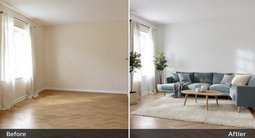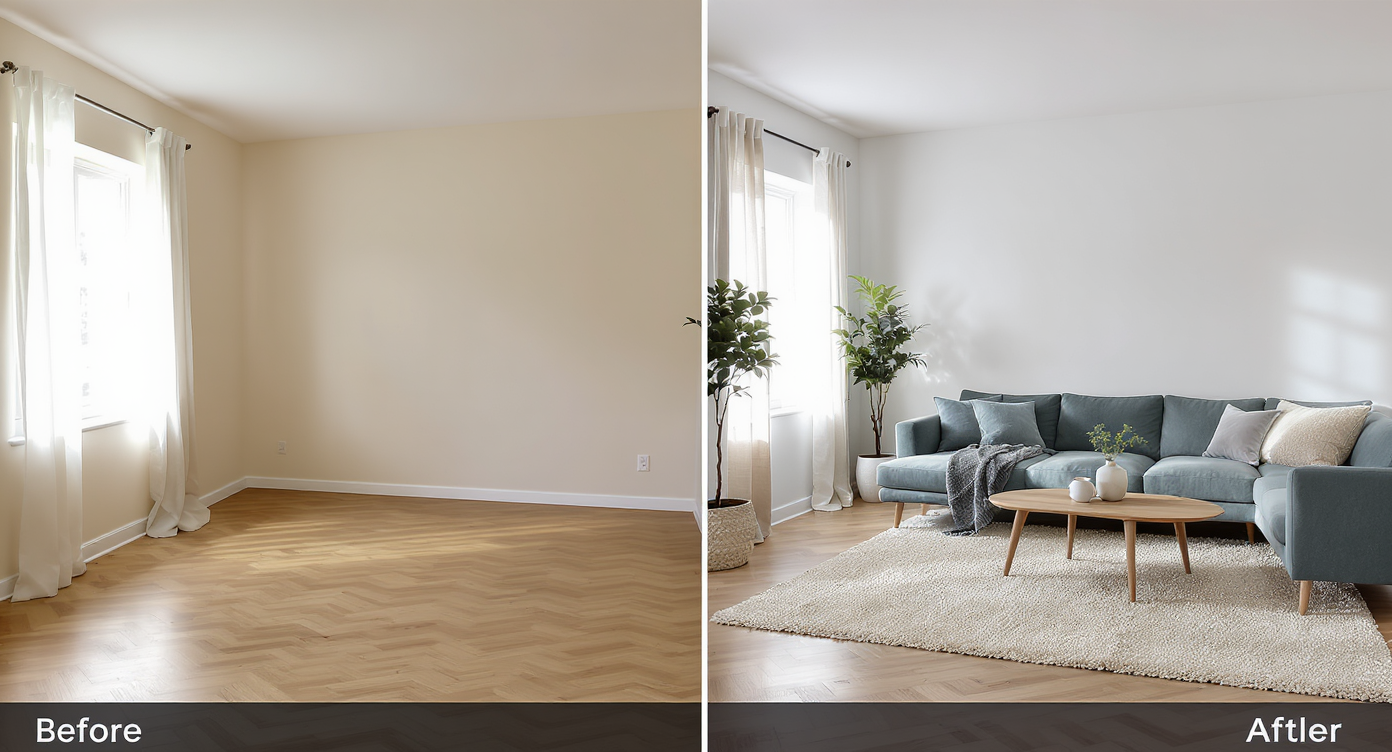TL;DR
Virtual staging for real estate listings works when it’s transparent, scaled correctly, and paired with floor plans and 3D walkthroughs. Label every image, keep edits realistic, and give buyers a toggle to see both staged and empty rooms. Expect higher click-through rates and fewer tire-kicker showings.
Introduction

Tools for clear, honest virtual staging: 3D tours, floor plans, and transparent labeling build buyer confidence.
Practical guide to virtual staging that buyers actually trust. Clear labeling, true-to-scale furniture, floor plans, and 3D tours included.
Hate Virtual Staging? Here’s How To Do It Right — And Win Buyer Trust
Virtual staging can feel fake. When it’s done well, it clarifies space, reduces wasted showings, and helps homes sell faster without misleading buyers.
Let’s be real: a lot of virtual staging looks like a video game screenshot. Floating sofas. Shadows that make no sense. Furniture that’s either dollhouse tiny or comically oversized. That’s why some buyers swipe past the listing the second they sense something’s off.
Here’s the thing. When virtual staging is transparent, scaled properly, and consistent with a floor plan and 3D walkthrough, it works. Agents often report 20–50% higher listing engagement and fewer unproductive showings when buyers can visualize the layout before touring. One quotable rule: buyers forgive “digital,” they don’t forgive “deception.”
(Alt text idea: Empty living room and virtually staged version with scale-correct sofa and natural light. Caption: “Clearly labeled ‘virtually staged’ with link to empty photo.”)
Core Strategy / Direct Answer
The playbook buyers and boards accept
Virtual staging for real estate listings is most effective when you pair visuals with facts and clear labels. Industry surveys consistently show that staged photos help buyers imagine living in a property, but mis-scaled furniture and unlabeled edits erode trust fast.
- Label every image: Add a small corner watermark that says “virtually staged.” Many MLSs require explicit labeling and prohibit altering permanent features like power lines, cracks, or views. Agents often advise, “Enhance, don’t erase.”
- Show both versions without confusion: Create two galleries — empty and staged — or a simple on/off toggle. Market analysts suggest this cuts cognitive friction and keeps bounce rates down on mobile.
- Get the scale right: Measure wall spans and note ceiling heights before staging. A quick check: if the render allows a nine-foot sectional in a ten-foot room, it’s wrong. Buyers have a radar for scale.
- Add the facts: Include room dimensions, a floor plan, and a 3D walkthrough. Buyer behavior studies show floor plans can reduce unnecessary showings by filtering out poor fits early.
- Match the light and architecture: Keep finishes, window glow, and shadow direction consistent with the original photo. Experts recommend staying within the home’s style — modern on modern, traditional on traditional — to avoid a visual disconnect.
Cost and ROI matter. Typical virtual staging runs $15–$75 per image, while physical staging can cost $2,000–$5,000 for a small home. Even a 1% price lift on a $500,000 property equals $5,000 — more than covering a robust digital package.
Why this improves lead quality
Listings with strong visuals — staged photos, floor plans, and a 3D tour — tend to attract more serious buyers. Agents often report a better showing-to-offer ratio because online viewers self-select after seeing the space clearly. One quotable line: “Good staging earns attention; good context earns offers.”
Anecdote
An agent’s turning point came with a narrow rowhouse. By publishing a floor plan and a clearly labeled staged view, the sofa and chairs finally “fit” the space online. The first weekend produced two serious buyers and one offer — replacing weeks of aimless showings on previous listings.
Common Mistakes & Misconceptions
Common mistakes that kill trust (and how to fix them)
Homes with virtual staging sell faster, according to agents who’ve tested it — but only when the presentation is realistic and honest.
- Alternating empty and staged images in one carousel: It’s disorienting on mobile. Fix it with a clean toggle or separate galleries labeled “Empty” and “Virtually Staged.”
- Furniture not to scale: Oversized sectionals in narrow rooms shout “misleading.” Fix with measured walls and a quick scale grid before rendering.
- Over-editing architecture: Removing power lines, patching cracks, moving walls, or changing views can violate MLS rules. Fix by limiting edits to add/remove furniture and non-structural decor.
- Unreal lighting and shadows: A couch casting a noon shadow under a dusk sky breaks the illusion. Fix by matching the photo’s real light direction and color temperature.
- No floor plan or dimensions: Buyers need context. Fix with a simple 2D plan and clear room sizes on every listing.
Pro Tips / Expert Insights
Pro tips from the field
“Stage for phones first — most listing views happen on mobile.” Photographers and marketers routinely optimize for a vertical crop, bigger text labels, and simplified furniture sets.
- Pick 1–2 buyer profiles and style to them: Urban minimalist? Family-friendly transitional? Agents suggest tailoring decor to likely demographics to boost relevance.
- Use fewer, larger pieces: One clean sofa, two chairs, a scaled rug, and a single art moment often read better than eight small items. Less clutter equals more clarity.
- Anchor with a rug to define zones in open plans: Buyers struggle to decode open spaces. A rug creates scale and sightlines that photograph well.
- Publish alt-text-like captions in copy: “Virtually staged for scale; see empty photo and floor plan.” Clear microcopy reduces bounce and questions.
- Bundle assets: Pro photographers, a 3D walkthrough, and a measured floor plan often cost the seller less than one price reduction — and can save 1–2 weeks on market in many areas.
Anecdotes & Real Stories
Real stories that changed minds
What turns skeptics into believers is usually one listing where virtual staging is done right.
- The busy seller: A broker added a 3D walkthrough and a clean, labeled set of virtually staged images for a townhome. Showings dipped slightly, but the showing-to-offer ratio improved, and the seller appreciated fewer interruptions. “Fewer showings, better offers” became the takeaway.
- The overwhelmed buyer: A house hunter admitted skipping listings where empty and staged photos were shuffled together. When she encountered a toggle labeled “Empty / Virtually Staged,” she engaged longer, saved the listing, and booked a tour. Organization restored trust.
- The investor flip: An investor with a narrow living room used scale-correct furniture and a floor plan highlighting a 10-foot width. Transparent staging eliminated the “is this as big as it looks?” doubt and helped land an offer 1.5% above list after seven days.
- The open-plan dilemma: In a new build that felt like a blank warehouse, a minimal Scandinavian layout — one sofa, two chairs, a large rug — clarified traffic flow. Buyers said the space finally “made sense” online.
(Alt text idea: Side-by-side gallery toggle showing empty vs staged great room. Caption: “Toggle to compare — no photo order whiplash.”)
Visualization Scenario
A buyer scrolls on her phone. She taps “Virtually Staged” and watches a blank great room resolve into a scaled sofa, two chairs, and a rug that defines the seating zone. A toggle switches back to “Empty,” while a thumbnail opens the floor plan. There’s no guesswork, no whiplash — just clarity that turns curiosity into a tour request.
FAQ
FAQ
- How much does virtual staging cost for real estate listings?
Virtual staging typically costs $15–$75 per image, while physical home staging can run $2,000–$5,000. Many agents find the cost-effective virtual option boosts online engagement for less budget. - Is virtual staging worth it for agents in a shifting market?
Yes — when labeled and to-scale, virtual staging and 3D walkthroughs can lift clicks 20–50% and trim days on market by a few days, according to agent reports. It also improves the showing-to-offer ratio by filtering out poor fits. - Can buyers tell if listing photos are virtually staged?
High-quality virtual staging looks real, but it should always be labeled to avoid distrust. Mis-scaled furniture or impossible shadows are red flags that turn buyers away. - What’s the best way to market real estate listings online with virtual staging and floor plans?
Publish two galleries — empty and virtually staged — plus a measured floor plan and a 3D tour. Keep captions clear, furniture to-scale, and styling aligned to the home’s architecture. - Are there MLS rules for virtual staging I should know?
Many MLSs allow labeled virtual staging but prohibit altering permanent features or defects. Check your board’s guidelines and stick to adding or removing furniture and decor only.
Tags
- virtual staging
- home staging
- real estate marketing
- listing photos
- 3D walkthrough
- floor plan
- virtual staging for real estate listings
- how to market real estate listings online
Conclusion
Put the buyer’s brain first
Great real estate marketing is part storytelling, part disclosure. Use virtual staging to clarify scale and lifestyle — not to invent a reality. Label every image. Pair it with dimensions, a floor plan, and a 3D walkthrough. If you do, you’ll earn the metric that matters most: trust that converts to offers.
Tools to try
- ReimagineHome for realistic virtual staging and design variations that keep scale honest.
- Matterport or similar for 3D walkthroughs buyers can navigate on phones.
- Simple floor-plan tools to publish dimensions alongside photos.
- Light post-processing in Canva for consistent brightness and contrast.
Ready to test a cleaner, more transparent approach to listing visuals? Explore AI-powered staging and variations with ReimagineHome and pair it with a floor plan plus a 3D tour.




.svg)

.svg)



.png)